September 20th, 2010 · 1 Comment
London is a very funny (not comedic, but more ironic) place in many ways. One of the most obvious examples of this is how it deals with religion. Londoners are surrounded on all sides by beautiful churches and cathedrals that were built from sometime after the Great Fire of 1666 (and maybe before… Any MEMS majors that want to correct me are more than welcome to) to the present day. Seemingly increasing this effect is the fact that the UK government (technically the Queen) basically runs religion in the country. As we’ve learned on our tours of various religious sites, there is not only a nationally-run church (The Church of England) but also a nationally-run synagogue (the United Synagogue). Just to clarify, by “church” and “synagogue,” I mean an organization of churches and an organization of synagogues, not single buildings. It would make sense, at least to most Americans used to a separation of church and state, that the close ties between religion and government would result in higher amounts of English citizens being religious. However, that is not the case. Focusing on the Christian faith, simply because it is the largest in England by a wide margin, and has seen the largest decline in believers (though not members, a phenomenon that I’ll get into soon), the Christian sites that we visited were generally much more “touristy” than they were religious. Westminster Abbey is basically just a museum at this point, used by tourists to see the burial places of famous people like Mary Queen of Scots, Clement Attlee, Neville Chamberlain, Charles Darwin, and Geoffrey Chaucer (and the list goes on), rather than being used as a church (which is what it was built for). Of course, it’s also used for coronations, remembrance ceremonies (like the one for the 70th anniversary of the Battle of Britain ceremony yesterday), etc., which are really religious ceremonies. Interestingly, at the Abbey, a prayer is read over an intercom every hour, which might be meant to try to hold on to a bit of the religious feeling of the place that it has lost over the years.

Personal Photo of Westminster Abbey
St. Paul’s Cathedral is much the same as the Abbey in many ways. It too serves more as a tourist destination than a religious destination. I completely understand this, as it’s a beautiful building (in my opinion), and it’s even more fantastic when you climb to the top of the dome and see the whole city below you.

Personal Photo from top of St. Paul's
It too has a problem with being religious, which it tries to remedy by having token religious ceremonies. I went to Evensong there one night rather early on in our program, and it was fantastic. You just can’t beat seeing a church service (almost entirely sung) in a building so beautiful, both aesthetically and acoustically. However, it feels that this service (which I believe happens every night) is done just so the people running it feel like they’re still running a church, and not a museum.
The third church that I’d like to discuss is St. Martin-in-the-Fields, located near Trafalgar Square. This church is a bit different from the rest, because they actually have regular church services (in English and Chinese, interestingly enough). However, they also host a lot of concerts, including regular jazz nights. For example, when we went, there was a woodwind trio playing classical music, which was fabulous. I find it interesting, tying this into my theme, that even a church that has a thriving congregation still feels the need to provide secular events to the general public.
So what does this all mean? Why are all of London’s churches trying to appeal to secular people? The answer is simple: the Church is dying. Over the past few decades, England has become radically more secular, and only a small percentage (compared to most of the rest of the world) go to church regularly. This doesn’t stop over 77% of the English from saying that they’re Christian (according to the CIA World Factbook, because I don’t have Watching the English with me at the British Library, and really needed that stat), of course. The interesting part about government-controlled religion is that it is exactly that, as opposed religion-controlled government. Americans typically believe that the separation of church and state prevents crazy religious fanatics from taking over the government (which it obviously doesn’t, seeing as how the entire US government is run by crazy religious fanatics, which is only a slight exaggeration), when instead it just prevents government from controlling religion. In the UK, the government has somehow squeezed the life out of religion, so that it is possible to be an Anglican and completely non-religious at the same time. Because religion has lost its meaning to many of the English, churches have started to become tourist destinations or something approximating community centers, just to stay alive. I haven’t really decided whether or not this is a good thing, but I certainly enjoy being able to visit these places without feeling like I have to pretend to be religious while I’m there.
Tags: 2010 MatthewM · Churches and Cathedrals
September 20th, 2010 · No Comments
London’s public parks are impressive, in their size, beauty, and sheer number. Most people go to these parks to play sports, have picnics, hang out with their mates (both kinds), sit and read under a tree, etc., but my favorite park activity is people watching; and nowhere in London is the people watching better than in Hyde Park’s Speaker’s Corner. Speaker’s Corner is like an internet chat forum come to life, attracting people from every imaginable social background and point of view. Immaculately dressed women toting around their four figure handbags walk by elderly Sikh men in skull caps with long, gray beards. Middle school aged children in football jerseys weave between bikers and joggers. Indian grandmas in wheelchairs are pushed by their grandkids past punk teenagers in six inch platform boots. London’s parks truly attract all kinds, and Speaker’s Corner is the ideal place to find a varied audience if you have something to say, simply set up your little stool, hop on, and begin your diatribe against the government, the media, the cursed masses, who or whatever. If you have anything even remotely interesting to say, a crowd will soon form around you. Wearing a funny costume doesn’t hurt either, the crazier the better.

Just a guy feeding the pigeons. (personal photo)
I’ve simply strolled through most of the parks here, stopping every now and then to admire a flower or dodge a pile of dog poop, but Hyde Park caught my attention and kept it. Right across from the tail end of the Oxford St. madness you will find the Marble Arch, and beyond it a massive expanse of green space. Speaker’s Corner is lodged conveniently in the middle. The first character I encountered was a militant African man speaking out against the war in Iraq. He looked to be about 25 or so, and around him stood a rather sizable crowd. There was also a group of four physically fit 20 somethings advertising a personal training service and attracting quite a crowd with their boxing gimmick. One of the men held up a pad on each hand and challenged people in the crowd to get in 200 punches in one minute. A group of south asian men egged each other on in friendly competition as the crowd laughed and cheered. I was asked to participate, but declined the request. After I had had my fill of watching overweight middle-aged men try and fail to show off athletic prowess, I moved over to listen to a capital C Crazy preacher and the bemused, laughing, and heckling crowd around him.
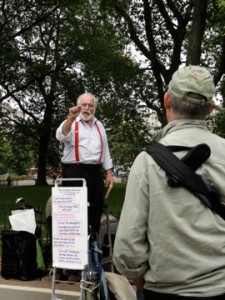
Belligerent preacher pointing at me and asking me something silly like if I knew where I was going when I died. (personal photo)
My favorite speaker was a grizzled old man sartorially channeling the Gorton’s Fisherman. He had a much smaller crowd around him, an interesting mix of homeless people and business men in suits and ties, and me. He wasn’t so much Speaking as having an intimate conversation with his little crowd, discussing poetry and painting, interspersed with personal anecdotes of questionable validity.
Past all of this, Hyde Park is like all the rest, and if you walk in far enough you will undoubtedly be able to stake out your own patch of serenity. Muslin women in full burkas sit and read, couples sit shoulder to shoulder on blankets, its all really a very nice scene. I guess the behavior in the park could be described as English, in that, aside from the liminal space of Speaker’s Corner, people seem to keep themselves, on the whole, its all very orderly.
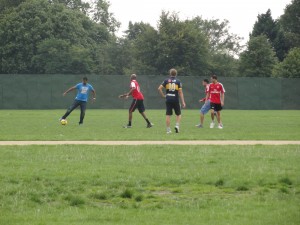
Mates playing a bit of footie. (personal photo)
Tags: 2010 Rachel · Uncategorized
September 20th, 2010 · No Comments
We were asked by our professor to investigate the culture and society that revolves within and around pubs in London. I honestly think he didn’t even have to require us to do it; we did it instinctively. But nevertheless I did what I was asked to do grudgingly, just kidding, I definitely did it willingly. And what I found in my short experience with pubs was that to the British or Londoners in general the pub is the equivalent of the American coffee shop with just a little more pizzazz.
Since our first day in London we have been to a variety of Pubs ranging from overtly tourist pubs to a bit more native pubs. In all the pubs that I visited there is a sense of privacy. Some people who have just gotten off of work go to pubs with co-workers discussing the day’s events over a pint. Others go to pubs alone seeking a sense of solitude to relieve some of the stress. Yet, others attend a pub to see the playing field pick up on someone and maybe have a good night. That is why drinking in the United Kingdom has a largely different connotation to that of the United States. I believe it has more of a positive air than back home. Yes like any other place there are alcoholics here but the majority that I have seen are able to compose themselves and carry on with life.
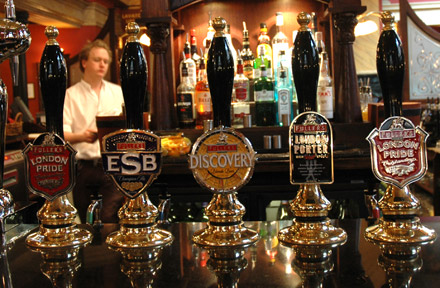
I definitely had to learn a couple of things when it came to ordering drinks and food at pubs. I first had to learn that customer service in the UK is virtually non-existent. Second there are no waiters what so ever, you go to the bar and order for yourself. Third and this is the most important part, you have to KNOW WHAT YOU WANT BEFORE YOU REACH THE BAR. If you fail at any of these three unwritten guidelines there is no ale for you. Considering I am a fast decision maker I had no trouble with this but I have definitely seen people get some glares of annoyance when they reach the bar and hold up the line.
As George Orwell wrote in his essay entitled The Moon Under Water, people favor not over the beer that they sell or the furniture they but instead its based upon what they call “atmosphere”. From the pubs I have been to my favorite by far has got to be the Marlborough Arms. What makes this my favorite from all the other pubs I have been is based on two aspects. The first is simply that I have been there so many times the staff already knows me and they crack jokes with me. It makes me feel like I am part of the establishment and above all makes me feel welcomed. And second they always, always have the best selection of American music. They play music that I haven’t heard in years. The place just simply lifts up my mood.

Pubs have been a place for people of diverging backgrounds to convene and have in depth conversations of life, politics, and religion. This has been true of London in the past where great minds discussed the status of the general welfare, like Karl Marx, and it is still true today. I have grown to love and appreciate the pub scene in London, and I look for forward to this next year.
Tags: 2010 Jamie · Uncategorized
September 20th, 2010 · No Comments

While I do not think anyone has encountered a pub serving beer out of strawberry-pink china mugs like George Orwell describes in his article The Moon Under Water, I think Orwell’s definition of what makes a pub great rings true today. It is less about the alcohol or food served, and more about the feel of the place. A pub’s atmosphere is what makes it great, and every pub I have visited certainly has its own distinct personality. From the Jack Horner’s somewhat upper-class, snobby atmosphere (the presence of poached salmon on the pub menu was rather unappealing) to the Marlborough Arms more casual, friendly interior, each pub in London seems to offer something slightly different.
The fact that each pub feels different is actually a little surprising, as I’m sure many have noticed the fact that there appears to be about five pub “companies” that own a bunch of different places around London. Every new pub I go into at this point, I recognize the menu because it is shared with a least twenty other pubs. Luckily, as Orwell points out, a pub is not based on food and drink alone. No, the differences in the pubs are really in the clientele they serve. Younger pub-goers and tourists make a place much more rambunctious and bar-like, while older patrons and locals will make a place more casual and homey.
The two strongest indicators of who will frequent a certain pub, and as a result dramatically change its atmosphere, are location and closing time. The more off-the-beaten-path a pub is, the less likely tourists and young people will go there. These pubs tend to be much calmer and feel like old institutions. However, if a pub is on a main road or near a big landmark, you can bet that the pub will be packed and playing loud American music, like the Rocket on Euston Street, a few blocks from the train station. Closing-time might be an even stronger indicator. Many of us have become fans of The Court on Tottenham Court Road for its 2 a.m. closing time, and it’s clear that other young twenty-somethings are attracted to the pub for the same reason. As a result, The Court is much louder and more bar-like than other pubs that close by 11 p.m.
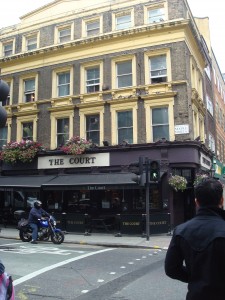
I and many of my peers have tried adhering to Kate Fox’s pub rules, with mixed results. Generally, the more off-the-beaten-path and traditional the pub, the more likely you could buy the owner a drink or observe an invisible queue. You are also far more likely to see actual regulars at one of these pubs than you would at, say, The Court or The Rocket. Regulars cannot easily fit into one category, but you can usually spot them out by their attitude. All of them seem to congregate close to the counter, and are visibly more relaxed than other patrons. Hopefully, we will someday match the relaxed tone of these regulars. Until then, I will continue to observe pub rules and try to figure out where they actually apply.
Tags: 2010 Andrew
September 20th, 2010 · 1 Comment
Back home it never sounded appealing or entertaining to me to see people run around in less than a 30ft area singing and jumping. Much less did I find the price tags of theater plays appealing, with prices generally starting at $100. Therefore, it is safe to assume that beyond school functions I had never seen a professional theater play in America.
That all changed, however, the minute I landed in London. In England people generally value art and the art of performance itself a lot more than in the United States. In the United States for example a performance always has to be entertaining above all this I feel has lowered the quality of shows. In England the people will continually go see a play even if the ending does not leave you with that warm fuzzy feeling and example of which is Billy Elliot.
My experience with plays here in London began with none other than William Shakespeare’s the Merry Wives of Windsor. It was a very good production, but it did not leave me with a feeling of must go see more plays. My second experience was Les Miserables. This show was not a required viewing by my professor but instead I decided to go with a large group of people from my program. I have always heard such good things about Les Miserables I had to just go see it. What a good decision that was. For only £15 or ($22) I not only got one of the best vocal performances I have ever seen, but I was given a political message throughout the storyline. In just 30 ft of limited space a group of 25 people were able to show me all of that. I was sold on the idea of theatre; I finally understand it and am now so willing to go to more. To this point in time Les Miserables is my favorite play.
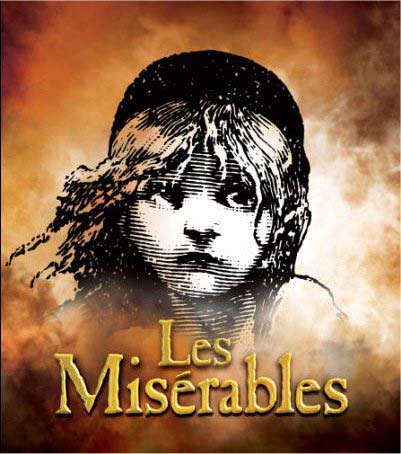
After this show the group switched gears and went to see a show called 39 Steps; which although it was set in the time period leading up to World War II it turned out to be a comedy. The cast of this show was only a whopping 4 people. Props were limited and the space even smaller than before. These people, however, were able to not only make me laugh but make it seem that they had gone to the country side, on a train, in a manor, and in an apartment. It was amazing, the creativity of such a production. The last show we have seen was The Habit of Art, this show like the one before was also a comedy. The organization of the show was a play within a play, like a behind the scenes movie. The messages from the show and social commentary were surprisingly dead on with what I believe. If there is one thing these shows have taught me is to definitely be willing to go to performances that are little known because sometimes they will be some the best times you’ll have.

The last aspect I noted in all these viewings was the type of audience they all have. Unlike America since the price of shows in London are significantly more accessible the class range of people who attend is astronomically different than back home. I also saw more of the younger generations attend shows here rather than the typical Grandma taking their kids to the show. The only type of people I didn’t notice, which could have been a result of bad observations on my part, was people of non-british backgrounds.
Overall my experience with the theatre in London has been extremely positive and I only look forward to expand my horizons by possibly going to see Operas like La Boheme.
Tags: 2010 Jamie
September 20th, 2010 · 2 Comments

One of the things that make London distinct from almost any other city I have visited is the amount or room dedicated to parks. Walk a few blocks and you are bound to encounter a vast expanse of greenery, or see a small garden area with some benches and statues. While a few of these parks (particularly Greenwich) are more organic in nature, and feel just like large open space areas to roam, most of these parks feel planned out to the last blade of grass. Hyde Park boasts a picturesque lake(The Serpentine) with neatly laid out park benches around it. The grass in St. James’ Park is always perfectly cut, and the main bridge in the middle of the park looks like it was installed yesterday. The shrubbery and gardens in Regent’s Park remind one of Versailles. All of these places seem sculpted to be as visually pleasing as possible.

The trend seems to be that the more central the park to the center of the city (Particularly St. James’ and Regent’s Parks), the more likely the park is to be perfectly planned and sculpted. There are several possible reasons for this. One, it could simply be that the city anticipates more people going through these areas, so they want them to look the nicest. Another possibility is that they expect these areas to get the most tourists, and the parks exist more for image than actual recreation (a point I’ll get to a little later). Finally, it could be that these areas are closest to the monarchy, and they have more of a say over these parks. Whatever the reason, there is no doubt that the parks in London are far more mapped out and planned than a majority of parks in American cities.
The question now is: is such planning a good thing? I personally see it as more of a mixed bag. The parks here are much more visually stunning than most I have seen elsewhere. The feel of the parks harkens back to the original intention of the parks: to make the poor and unprivileged feel like they had access to the wealth of the monarchy. You really feel like you are walking through the Queen’s personal gardens when you take a stroll through Regent’s Park. However, this meticulous planning takes away a little bit of personality from the parks. I get no sense of true, organic, nature while walking through St. James because everything feels so mapped out. In addition, the regal nature of the parks appears to hinder a lot of activity within the parks. Most people seem to simply be walking slowly through these areas, or sitting on a park bench. There are rarely any cyclists, joggers, Frisbee players, kids running around, or anyone playing games. This inactivity is partially because a lot of games are banned in certain areas of the parks, but I think it is also due to the intimidating nature of such perfectly sculpted areas. After walking through the immaculately-trimmed hedges of Regent’s, or after crossing the bridge in St. James’ with the marvelous view of Buckingham Palace, it is hard to think: “Gee, this is the perfect place to run around and throw a Frisbee.” As a result of such overplanning, the parks lose this energy, and also a little bit of quirk.

I love the fact that London has so much green space, and that the city takes such good care of these areas. However, the parks are so meticulously sculpted that the areas seem almost unnatural. The lack of physical activity makes the area feel calm, but it also takes something away from its overall personality. I have enjoyed my time walking through London’s parks, but one wonders whether a bit less planning would make these areas more fun and inviting to the public.
Tags: 2010 Andrew














